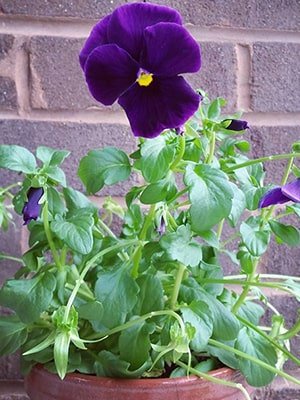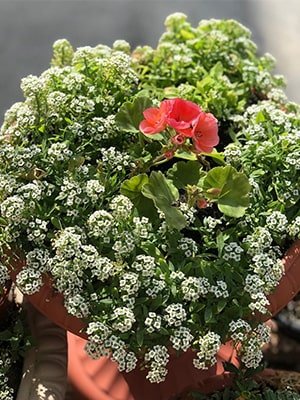The end of summer doesn’t mean the death of colourful plants; in truth, fall may be an excellent time to plant a new crop of blooms. Fall garden plants give new life to your garden.
There’s no deficiency of blooms to select from to organize the idealized harvest time cultivate with eye-catching colors extending. The drop may be an excellent time to plant perennials and bushes when temperatures are less extraordinary, and precipitation is abundant.
Do you want to grow flowering plants in the fall season (from 23 September to 21 December) or make your garden attractive? Then here are some beautiful fall-blooming flower plants for your garden that bloom in fall.
Best Garden Plants for Fall Season
1. Pansy Plant

Pansy plants are colourful blossoms with “faces.” Brilliantly flexible and overwhelming blossoming, pansies are maybe the idealized drop blossom. Pansies see lovely on their claim in a monochrome plot or blended colours.
Pansies have heart-shaped, covering petals and one of the most extensive ranges of shining, lovely colours and designs. Pansies are shockingly healthy in a cold climate, even though. They’ll survive a frost, bouncing back from indeed single-digit temperatures.
If the blooms wither in the cold, the plants will frequently remain lively to sprout once more, making them an extraordinary blooming plant for drop and early winter colour.
2. Celosia Plant (Cockscomb)

Celosia (Cockscomb) plant could be an ornamental plant within the family “Amaranthaceae”. The blossom heads take after ahead of wheat or a bottle brush. The bloom colours are not as shining as with other sorts, but they come in rose-pink, white, and dim red assortments.
The bizarre-looking yearly blooms can sprout for up to ten weeks, with Celosia bloom heads of ruddy, purple, gold, pink, or some of the time bi-coloured bloom colours. This is an assortment (variety) of dynamic colours and shapes. One shape with smooth, unsettled looks like a brain.
3. Croton Plant

Croton plants are naturally bushy plants with broad, rough, glossy leaves. Crotons are local to southern Asia and certain Pacific islands, where they develop as semi-tropical plants. Croton plants can create tiny, decently immaterial blooms.
They do blossom, but their modest, star-shaped yellow blooms are inconsequential, hanging down in long clusters between the enormous leaves. Croton takes a parcel of vitality from the plant. Crotons create their best leaf colour when kept in shining light.
Outside, they incline toward the fractional sun, with shade for a few hours each day. Inside, they do well in a shining dowager that faces south or southwest. Since they are semi-tropical, they moreover prefer a humid environment.
4. Flowering Kale (Ornamental Kale) Plant

Flowering kale (ornamental kale) Plant is with its unsettled leaves soaked in pinks, purples, and red. Flowering kale may be an enriching and easy-to-grow addition to holder gardens and plant beds. Typically it is called decorative cabbage.
The round-shaped plants have wavy external leaves that stay medium to dull green, whereas the flower-like centres gradually alter colour. It holds up well to frosty temperatures and looks great all winter long in mild-winter ranges. Blooming kale could be an embellishing and easy-to-grow expansion to holder gardens and plant beds.
5. Aster Flower Plant

Aster flower plant is often blooming plant within the family “Asteraceae”. Asters are daisy-like perennials with starry-shaped blossom heads that extend in colour from white to blue to purple. They bring delightful magnificence to cultivate in late summer and harvest time.
Aster blooms include colour to the harvest time scene, whereas advertising magnificence with small work when caring for asters. Flowers are in shades of purple, pink, white, and blue. Aster is one of the most delicate plants to nourish hungry bees and butterflies in autumn.
6. Mums Flower (Chrysanthemum)

This is often the genus of family “Asteraceae”. Mums are local to East Asia and north-eastern Europe. Mums make a cushion of colour in bright regular shades of red, orange, yellow, peach, and white and differentiating shades of pink.
They have a vast number of petals. This herbaceous and tough lasting is a straightforward expansion to donate a perfect pop of colour in your drop cultivate scene. They are staples in drop gardens. Mums are a national symbol of fall abundance. They are accessible in numerous sizes.
7. African Fountain Grass

This can be genius of family “Ponceau”. This plant is so attractive. It isn’t a cold-hardy plant, but it is well worth developing in cold-winter locales indeed if you’ll appreciate it for as it were two seasons out of the year.
The excellence of African fountain grass makes it well known as a central point in blended planting, and it is regularly utilized in holder gardens. But you’ll be able to mass several of the plants together, such as in a border planting.
It’s development Size is 3 to 5 feet tall and 2 to 4 feet wide. Typically exceptionally valuable in drop bloom gardens.
8. Sweet William Plant (Dianthus Barbatus)

Sweet William Plant is often a tremendous biennial expansion for spring to summer blossom with the bounty of fragrance. Sweet William offers lovely blooms and wonderful scents. This is often a prevalent ornamental and edible blossoming plant local to parts of Asia and Europe.
Sweet William Plant (Dianthus Barbatus) may be a biennial or short-lived lasting prized for its thickly stuffed, straightened clusters of tiny flowers. The plant, developing to a height of 60 cm, produces various blossoms white, pink, rose to violet, or now and then bicolored with bordered petals. It is utilized within the botanical industry for its cut blossoms.
9. Sweet Alyssum Plant

This is often a low-growing flowering plant within the family “Brassicaceae”. Sweet Alyssum plant may be a sensitive carpet of little blooms with an inconspicuous, sweet fragrance. This is a fancy for its fragrant clusters of little white four-petaled blossoms.
There are green shapes with lavender, pink, or purple blooms. Its grey-green leaves are marginally shaggy, limit and lance-shaped. The low-growing foliage covers the ground with little cross-shaped, four-petal blooms for much of the developing season.
This can be a brilliant cool-season yearly that has been a long-time favourite since of its delicate blooms on tidy hills of foliage.
10. Capsicum Annuum (Ornamental Pepper Plant)

The ornamental pepper plant (botanical name: Capsicum Annuum) is often developed as a yearly plant indoors, although it’s a perennial when developed within the adjust conditions. These plants offer colourful natural products in festive shades of red, yellow, orange, and purple. There are diverse shapes and sizes accessible.
Capsicum Annuum reaches 10 to 20 inches in stature. The pointed, elliptical leaves are ordinarily medium-green, although a few cultivars have variegated or purplish-black leaves such as “Dark Pearl,” which has purplish-black leaves.
11. Viola Flower (Violet Plant)

This is often developed as a yearly plant indoors, although it’s lasting when expanded within the adjusted conditions. These plants offer colourful natural products in bright shades of red, yellow, orange, and purple. There are different shapes and sizes accessible.
Fancy peppers reach 10 to 20 inches in stature. The pointed, elliptical leaves are ordinarily medium-green, even though a few cultivars have variegated or purplish-black leaves such as “Dark Pearl,” which has purplish-black leaves.
12. Rudbeckia Hirta (Black-eyed Susan)

Rudbeckia Hirta is often genus of “sunflower family”. They are local to Eastern and Central North America. This plant has cheery yellow blossoms in late-summer. Rudbeckia will sprout for weeks with minimal care. The plants can develop to over 3 feet tall, with leaves of 6 inches, stalks over 8 inches long, and blooms with a diameter of 2 to 3 inches.
This can be too known as “Black-eyed Susan”. Dark eye is named for the dull, brown-purple centres of its daisy-like bloom heads. Butterflies, bees, and an assortment of creepy crawlies are pulled in to the blossoms for the nectar.
Hope, you love reading these fall garden plants. If you have more ideas then share it with us.
Have some questions or suggestions? Use our comments section on this blog! You can feel free to leave a comment below, and we’ll get back to you as soon as possible!
We love reading your messages……

